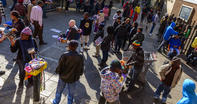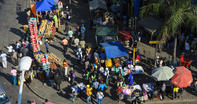Food Flows and City Geography
The preoccupation with food gardens as the solution to hunger in the urban household tends to hand responsibility over to the individual to deal with the problem of food security at a domestic level.

But this position diverts attention away from how the layout of the city and how the food retail system marginalises the poor even further. Municipalities need to understand the layout of their cities and how food flows into them, where the food hubs are (both formal and informal), and the location of these relative to the people who need to access them, in terms of both where they live and work.
This geography of the city, and how food moves around it, impacts on whether people are able to get good, nutritious food in such a way that they can be deemed food secure.
Looking at the Broader Layout of the City
And yet it looks as though the way food flows into these markets, both formal and informal, has not been well studied. As supermarkets become such a dominant force in the food retail system in cities, they become part of a city geography that creates ‘food deserts’, areas in the city where nutritious, affordable food is beyond the reach of poorer households.
Large supermarkets tend to have lower prices and a greater range of healthy foods but these shops are often inaccessible to the poor. Supermarkets tend to locate in more profitable, affluent areas, beyond walking distance for the poor. One way that geographers argue for cities to understand where food deserts are is to zoom back a bit, and look at the broader layout of the city and its food retail hubs relative to poorer, often carless communities.
Map a city’s retail outlets, the prices and types of foods in different communities, and then overlay this information on a map of the demographics of a city. For this tool to be effective, it needs to include all food market types, not just big formal retailers like supermarkets, but also farmer’s markets, grocery stores, convenience stores, restaurants and less formal food outlets.
This is important in the developing city context where, in South Africa for instance, the informal food trade was valued at between R20 billion and R30 billion annually in 2004.
Factors to Consider
There are other factors to consider, though, in terms of how individuals relate to the broader spatial nature of the city within which they access food. And an understanding of these would help cities to grapple with meeting the challenge of their citizens’ right to food.
Some of these include: how much time people spend travelling to get to food sources, rather than the distances themselves (or even how work-related commuting impacts on their time available to forage for food); social barriers such as crime; and individual mobility (are people lugging groceries home on foot, or using busy taxis?).
Another consideration is what geographers call ‘foodways’: examining the structure, type, density and proximity of food outlets. This means understanding how people grow, buy, prepare, use and share food within communities and that getting to grips with both the food environment and the foodways of a place is essential to understand the health (and other impacts) of the urban food system.
Considering Informal Markets

The idea of mapping food deserts, however, does not consider the informal markets as an important food source of the urban poor. Another problem with this approach is that it does not account for the fact that in many southern African cities, people do not shop where they live. Rather, poorer communities (particularly in South Africa) tend to live far from employment hubs.
In Cape Town, for instance, it means people tend to purchase food from a number of neighbourhoods, making a series of time, cost and quality negotiations to access their food.
City planners need to take this into consideration in order to deal with urban food security challenges. Where do people get their food? Yes, from formal markets and supermarkets, but also from informal markets, from food donations and through borrowing, and sometimes (but not often) from growing their own.
The Problem with Supermarkets
Even though supermarkets account for more and more of the food bought by South African consumers, some of the hurdles to accessing this cheaper bulk-purchased food include: Distances from supermarkets that add additional transport cost onto the final basket of food, and the dependence on taxis which makes it difficult to get the food back home.
Even though the food is cheaper by volume, it is often sold in larger quantities than at spaza shops, making it unaffordable (spaza shops tend to repackage larger parcels of food into smaller volumes, so even though the cost per gram of food might be higher once their own markup is added, the smaller quantity of repacked food is more affordable to a budget-constrained shopper).
Supermarkets do not offer credit, which local shopkeepers in the township might; and when supermarkets are located near transport hubs, which is often the case in townships, people feel vulnerable to muggers who assume that if they are buying lots of groceries, they have money on them.
By Leonie Joubert